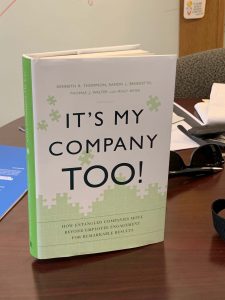
Today’s Buzz is by Greg Stopka (Twitter and LinkedIn)
What I am watching: Stranger Things Season 3 (I wrote this before July 4th premiere but I’m sure that’s what I’ll be watching on July 9th)
What I am listening to: Audio book of The Lost Symbol by Dan Brown (on a Robert Langdon fix)
What I am reading: It’s My Company TOO!: How Entangled Companies Move Beyond Employee Engagement for Remarkable Results
While many organizations have innovation strategies (innovation team, lean, etc.), the question remains how do you make innovation part of every employee’s work, and not just the ones involved in the current innovation strategies? What happens after they are done serving on the innovation team, when the special program ends, and the training is complete? Do they go back to the same old same old?
I had the pleasure of visiting Tom Walter’s organization Tasty Catering. While I love food, (seriously, one of my favorite parts of getting married was the food tasting), the reason for the visit wasn’t to try some new pastry but to observe the award-winning culture Tom has built. What I saw amazed me: employees using the values of the organization such as integrity, innovation, etc. to justify decisions they were making, tangible performance dashboards in the warehouse, and Tom explaining how each employee’s innovation improved the organization.
Check our my video of my tour @TastyCatering and how they build a culture of #engagement . Amazing #culture pic.twitter.com/1fsXpYNUcY
— Greg Stopka (@GregStopka) July 2, 2019
I’m now reading his book called It’s My Company Too!; How Entangled Companies Move Beyond Employee Engagement For Remarkable Results and it got me wondering: how did Tasty create an environment that allows employees to innovate in their day to day work, and what can local government learn from them?
As an ELGL me mber, you probably have read a budget or strategic planning document. They form the planning foundation of an organization. Ideally, the annual work for the organization derives from the strategic objectives set out in the strategic plan. Managers identify goals for their departments and the individual work is assigned to staff to implement. When I worked at the City of Yuma, the city manager assigned me the goal of developing a sustainability plan to take advantage of future sustainability grant and funding opportunities. But what if I saw another problem or opportunity related to the sustainability objective different than the one assigned to me? Could I explore it? Could I act on it? From my experience, much of government work leaves little room for innovation. How can we expect employees to innovate if all the work is planned ahead of time?
mber, you probably have read a budget or strategic planning document. They form the planning foundation of an organization. Ideally, the annual work for the organization derives from the strategic objectives set out in the strategic plan. Managers identify goals for their departments and the individual work is assigned to staff to implement. When I worked at the City of Yuma, the city manager assigned me the goal of developing a sustainability plan to take advantage of future sustainability grant and funding opportunities. But what if I saw another problem or opportunity related to the sustainability objective different than the one assigned to me? Could I explore it? Could I act on it? From my experience, much of government work leaves little room for innovation. How can we expect employees to innovate if all the work is planned ahead of time?
But what if instead of pre-assigning work, we allowed the employee space and time to innovate around it. In the book, the authors reference another company called Springfield ReNew Cuenter (SRC), a remanufacturing company. At SRC, they have a leadership system where employees are empowered to address problems and opportunities they see. Instead of relying on managers assigning work, employees develop their own work and even new business units, resulting in the company growing from 119 to 1,200 employees. SRC believes in giving employees a stake in the outcome which unleashes the full entrepreneurial potential of the organization.
Could something like this work in local government?
One way we are trying to embed innovation at the Park District is asking staff at the department level to identify problems or opportunities they see related to the organization’s strategic objectives or in their work. We can then take these problems to the innovation team to identify new solutions. However, while this is a good step to infuse innovation in the organization overall, I don’t think it’s the final step to incorporate innovation into employee’s work. Tasty Catering would say we need to assign the entire innovation process to the employee and not the innovation team. We are using the innovation team as a crutch for innovation because the rest of the organization doesn’t have time to do it. We are also creating the perception that innovation work is for the innovation team and the employee’s role is to suggest problems.
How can we flip the paradigm so all employees have innovation as part of their jobs like SRC has?
Michael Davis, Strategic Initiative Manager, and I were talking last month about the danger of over-planning. As government professionals, we like to plan but sometimes an approach where employees are allowed to experiment and learn can work better (or in other words design-thinking). Michael mentioned that he is increasing “using the language of testing as opposed to implementation, which can be rigid.” By focusing on a design mindset, we open ourselves and our communities to so many more possibilities.
How can we add design-thinking to our planning processes? One of the obstacles is the budget process itself. In the book Age of Agile, Steve Denning explains why budgeting often impedes innovation.
“At the core of traditional management,” Bjarte Bogsnes told me last year, “you find the budgeting process and the budgeting mindset. The budget is ‘the elephant in the room.’ An organization can never be truly agile unless you also address that budget mindset, and that process. It is necessary but not sufficient.”
Traditional budgeting align the costs and outputs of every single activity in a single comprehensive system. Where is the room for innovation? The process changes championed by the Beyond Budgeting movement is not to get rid of budgeting but to change traditional management and the budget mindset to allow for flexibility. One of their recommendations is to not allocate budgeting by department but by outcomes.
A great example of this is Baltimore, MD. In the ELGL article about the book “City on the Line,” (see #ELGL bookclub) author Andrew Kleine explains
The only inflexible element in a budget should be the result we need – everything else is negotiable. You start with the result you want, then let anyone (city or otherwise) propose their solution and the funds needed to make it happen. This is outcome budgeting in a nutshell. We should be asking, “Who can achieve this result and how much will it cost me”?
 Another great example is Fort Collins, CO’s budget which has “offers for consideration” that will address the community’s strategic outcomes. If you have a budget like Baltimore or Fort Collins that is based around outcomes, it’s much easier to infuse innovation into it.
Another great example is Fort Collins, CO’s budget which has “offers for consideration” that will address the community’s strategic outcomes. If you have a budget like Baltimore or Fort Collins that is based around outcomes, it’s much easier to infuse innovation into it.
Imagine you have a similar budget process to Baltimore or Fort Collins. What if each employee was part of a cross-functional team to explore an outcome and develop new ideas to address it using design-thinking principles. The work could result in new proposed pilot ideas that could feed future budgets and transform the organization. This approach is also an excellent way to connect the strategic objectives of an organization to the work of the individual employees. Staff would no longer need constant communication about how the strategic outcomes of the organization fit their work because they’d be living it.
Now you might be wondering, is Greg suggesting a world where government doesn’t have pre-assigned goals? Of course not. I’m not saying abandon all planned goals, I’m suggesting allowing space for innovation goals to complement them. Companies like SRC have cultures that have moved from a top down planning approach to one based around decentralized leadership, which allows employee innovation to blossom. By adding a design mentality, we can tap into the entrepreneurial potential of all employees and unleash the true innovation potential of our communities
